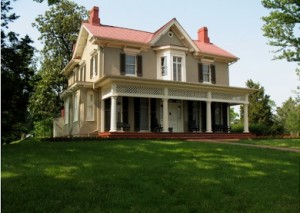Cedar Hill
Frederick Douglass lived the last eighteen years of his life in his Cedar Hill residence in Anacostia, Washington D.C. He purchased the house in 1877 and paid $6,700 to the Freedmen’s Savings and Trust Company, he and his family moved in the fall of 1878. Cedar Hill is now part of the Frederick Douglass National Historical Site and it is administered by the U.S. National Park Service.
Douglass’ Cedar Hill residence is open for tours and preserved by the National Park Service.
Third and last autobiography, Life and Times of Frederick Douglass
In 1881 Douglass published his last of three autobiographies, Life and Times of Frederick Douglass. In it he describes for the first time the means he used to escape from slavery and named those who helped him. He also explains his role in the Underground Railway.
Government posts
During his last twenty years he held a number of government positions. In 1881 Douglass was appointed by President Garfield as Recorder of Deeds for the District of Columbia. In 1888 President Harrison assigned him the post of Minister to Haiti but two years later he resigned his post due to a controversy. In 1891 he accepted an offer by the government of Haiti as commissioner to the World’s Columbian Exposition in Chicago.The controversy of a second marriage
Douglass’ family life experienced a turn of events when his long time wife, Ana, died on August 1882 after battling illness for years. The couple was married for forty years. Two years after Ana’s death, Douglass surprised his family and friends by marrying his secretary, Helen Pitts, a white woman 20 years younger than him. His long time lover, Ottilie Assing, committed suicide. Douglass’ children were displeased with the marriage. Pitts’ parents, even though they were abolitionists, did not approve of their marriage either. Douglass stated that first marriage had been to someone the color of his mother, and his second to someone the color of his father. During 1886 and 1887 the couple traveled extensively around Europe and remained married for eleven years until Douglass’ death.
Douglass’ Death
On the evening of February 20, 1895 after attending a meeting of the National Council of Women in Washington, D.C., Douglass returned home and unexpectedly died of a heart attack. His funeral was held at the Metropolitan African Methodist Episcopal Church in Downtown Washington. People, black and white, came from each corner of the country to pay tribute to the abolitionist, civil rights leader, writer and public speaker.
Read the New York Times article, Tributes of two races, about the funeral of Frederick Douglass.
His body is buried in Section “A” of the Mount Hope Cemetery in Rochester, New York. He was buried in Rochester instead of Washington D.C. because he lived in Rochester longer than anywhere else. His two wives, Ana and Helen, are buried next to him.
Frederick Douglass is buried at Mount Hope Cemetery in Rochester, New York.
Douglass left his Cedar Hill residence to his wife Helen but the will lacked a certain number witnesses and under the law it was ruled invalid. His children wanted to sell the property and divide the money but Helen wanted Cedar Hill to be a memorial to Douglass. Helen borrowed money and bought the property. She created the Frederick Douglass Memorial and Historical Association, a non profit organization. After she died in 1903 the National Association of Colored Women bought the property. Today it is administered by the National Park Service and the Frederick Douglass Memorial and Historical Association conducts tours in Cedar Hill.


